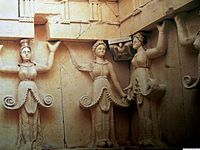Thracian tomb of Sveshtari
| Thracian tomb of Sveshtari Свещарска гробница |
|
|---|---|
|
UNESCO world heritage |
|

|
|
| National territory: |
|
| Type: | Culture |
| Criteria : | ii, iii |
| Surface: | 647.6 ha |
| Reference No .: | 359 |
| UNESCO region : | Europe and North America |
| History of enrollment | |
| Enrollment: | 1985 (session 9) |
The Thracian tomb of Svehtari ( Bulgarian Свещарска гробница ) is located 2.5 km southwest of the village Svehtari , 9 km northwest of Isperich, 42 km northeast of Razgrad in northeastern Bulgaria .
The grave from the 3rd century BC Was discovered in 1982. The half-human, half-vegetable caryatids are particularly unique . It is believed to be the tomb of the Getic king Dromichaites .
The Thracian tomb of Sveshtari has been a UNESCO World Heritage Site since 1985 .
The grave stands free on the top of a hill, just a few kilometers from the ancient city of Helis. The entrance faces east. The grave is assembled from massive, hewn stone blocks. Iron construction clips were occasionally used. Each of the three chambers has its own barrel vault. There is a burial chamber, offering chamber and antechamber. The main chamber contains two couches, one for the king directly opposite the entrance and a smaller one on the right side for the queen. Directly in front of the king's couch was a 2 × 2 m stone portico in the middle of the room, which was closed with stone slabs. It is believed that it should represent a symbolic separation between this world and the hereafter. The frieze is decorated with alternating animal heads and flowers. Numerous grave objects were found in the antechamber and the sacrificial chamber, including the remains of several horses. The antechamber was walled up to the outside. The entrance was flanked by a small wall to the left and right.
To preserve the grave, the mound was completely removed. Then a concrete bell was poured next to it and driven over the grave on rails. Then the mound was backfilled. After the restoration, the portico was not rebuilt in its old place, but on a wall outside the tomb. Otherwise tourists would not have been able to see him in the burial chamber.
In addition to the royal tomb, there are many other burial mounds. A total of 36 have so far been found in the vicinity of Helis. Four of them contained massive tombs like those in the royal tomb. So far only 23 hills have been examined. Dummies that did not contain anything were also found. Two more are accessible directly next to the royal tomb. They are significantly smaller and lower and only have one chamber each. However, they seem to have been reusable because they have revolving stone doors mounted on bronze. The door of the royal tomb was simply walled up. These less valuable graves now only have a corrugated iron roof to protect them from the weather.
Guided tours take place on the hour, alternately in English and Bulgarian. Entry BGN 15, - Unfortunately, your own photos are not allowed inside.
literature
- Alexandar Fol , M. Čičikova, T. Ivanov, T. Teofilov: The Thracian Tomb near the Village of Sveshtari. Sofia 1986.
- Alexander Fol: The Thracian Orphic or two ways to immortality , In: Die Thraker. The golden kingdom of Orpheus , exhibition, July 23 to November 28, 2004, Art and Exhibition Hall of the Federal Republic of Germany. Philipp von Zabern, Mainz 2004, pp. 177–186.
Individual evidence
- ^ Peter Delev: Lysimachus, the Getae, and Archeology . In: The Classical Quarterly New Series 50 (2000) pp. 384-401.
Web links
- Thracian Tomb of Sveshtari on the UNESCO site
Coordinates: 43 ° 44 ′ 41.9 " N , 26 ° 45 ′ 58.7" E

